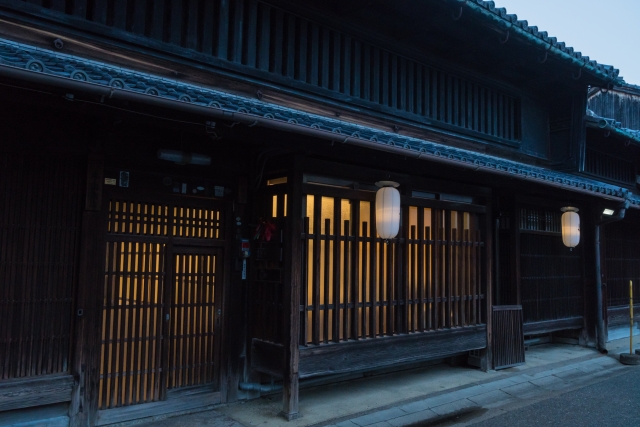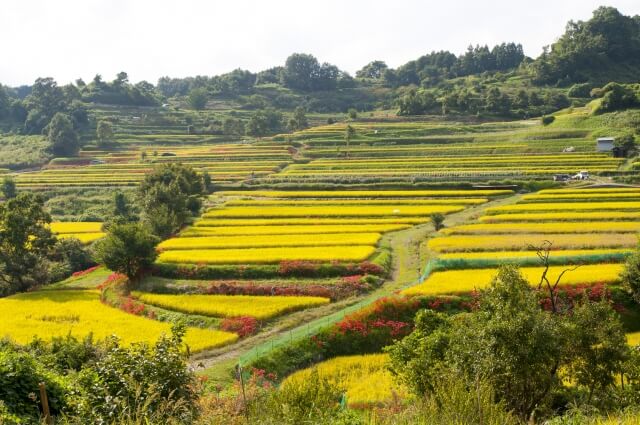Nara was Japan’s first permanent capital from 710 until 784, known at the time as Heijo. Before that, the capital city changed whenever a new emperor ascended to the throne. Nara is part of the Kansai region, with close proximity to other popular tourist destinations like Kyoto and Osaka (less than an hour away). Many visitors know the area because of the famous deer park, where the deer walk around freely, and a big statue of Buddha. These famous sites are close to each other, in fact they are within walking distance from each other.
Because of its close proximity to Osaka and Kyoto, you might think of Nara as just a day trip, but there so much to see, learn and do in Nara that you can easily spend two or perhaps 3 days here. In this article, we will share our recommended two days itinerary in Nara to make it easier for you to start planning your Japan trip.
How to get to Nara
As mentioned above, Nara is located in the Kansai region, within close proximity to Osaka (28 km east) and Kyoto (35 km south). In addition, it is also quite close to Kansai International Airport (77 km northeast). It is connected to all cities through a large network of buses and trains. From both Osaka and Kyoto you can take two trains to Nara, a JR operated line that you can use freely with your JR Rail Pass, and the private Kintetsu Line.
Travelling from Kyoto to Nara
Your best option from Kyoto to Nara is taking the train. You can either take the JR train that will take you to Nara station in 45 minutes, costs ¥720. The Kintetsu Line will take you to Kintetsu Nara station in 35 minutes, costs ¥1,160.
Travelling from Osaka to Nara
From Osaka you can also take the train. Either take the Yamatoji Kaisoku (express) from JR Osaka station to Nara station. The ticket costs ¥810 and the trip will take 55 minutes. Or you can take the Kintetsu Nara Line from Kintetsu Namba station, taking you to Kintetsu Nara station for ¥570 in 40 minutes.
From other parts of Japan, your best option is to take the Shinkansen to either Kyoto or Osaka and make your way to Nara as described above.

Day 1: Exploring Nara
10:30am Kasuga Taisha Shrine
Kasuga Taisha shrine is a registered UNESCO World Heritage Site and was founded about 1,300 years ago. When you get off the train at Kintetsu Nara Station, walk for about 30 minutes to get there. You will see hundreds of lanterns lining up along the pathway to Kasuga Taisha Shrine. The shrine is actually famous for the many lanterns that were donated by worshippers; there are some 3,000 different types of lanterns contributed since the 8th century till today. There are lighting up events at the shrine three times a year.


When you go there, make sure to visit the Fujinami-no-ya Hall. This traditional place is open all year for public and that you can see the beautiful hanging lanterns at all time. To enter the inner shrine though, a small admission fee (¥500) is charged.
12pm Naramachi for lunch

Head to southwest from Kasuga Taisha Shrine to walk around Naramachi neighbourhood, the former merchant district of Nara. Here you will see Japanese traditional houses called machiya lined up on both sides of the street. Some of them have been renovated as a cafe or restaurant, we recommend to have lunch there and enjoy the local atmosphere in this cute neighbourhood.
1:30pm Todaiji Temple

Nandaimon Gate of Todaiji Temple
Nandaimon means great south gate in Japanese and it is the entrance gate of Todaiji Temple.This gate is 25 meters tall and is the biggest gate in Japan. There are two statues of guardians called Kongo-Rikishi Statues which are said to date back to the in 13th century and were built in 70 days. Todaiji Temple is one of the most popular and famous spots in Nara so it will be crowded during the daytime. If you prefer the quiet time, we recommend you to go there at night or early in the morning.
Daibutsuden Hall of Todaiji Temple


This is the world’s biggest wooden building in which Daibutsu, the biggest bronze Buddha statue in Japan, is located. Originally the main hall was constructed in 752 as a headquarter of provincial temples. It has been reconstructed in a smaller size than the original one but still, the size of the temple is overwhelming.
Nigatsu-do & Sangatsu-do buildings of Todaiji Temple

These are the sub-temples of Todaiji Temple located on the hill from Daibutsuden Hall. In Sangatsu-do, there are small collections of unique old statues and this building remains as the original style from 7th century. Nigatsu-do is the building next to Sangatsu-do and they have two statues which are called eleven-faced kannon. Nobody can see these statues even the monks.
Entrance to the Daibutsuden Hall of Todaiji Temple is ¥600 and the hall is accessible from 7:30am to 5:30pm (Apr ~ Oct) / 8am to 5pm (Nov ~ Mar).
4.30pm Mt. Wakakusa


From Todaiji Temple, continue east and go to Mount Wakakusa located behind Nara Park. It is a short hike, about 15-20 minutes, to reach to the plateau and about 30-40 minutes to the top of Wakakusayama. You can enjoy a beautiful view from the top and it is totally recommended to stay there until the sunset! Mount Wakakusa is accessible from 9am till 5pm and a small admission fee of ¥150 is charged.
Kofuku-ji Temple

At Kofuku-ji Temple, the second tallest five-story pagoda in Nara lights up after the sunset. Our suggested spot to view the illuminated pagoda and the temple is from Sarusawa pond. After you’ve enjoyed the view, let’s head back to Naramachi for dinner.

Day 2: Visiting south from Nara
We would like to offer you two options to enjoy your second day in Nara.
If you feel like enjoying the nature, an old Japanese village and find some ancient ruins, we would recommend you to go cycling around Asuka Village (sample 1). Or if you want to visit more temples and World Heritage Sites, scroll down to our second suggestion.
Option 1: Exploring rural Asuka area

In the Asuka area, located south from Nara, you will find yourself surrounded by beautiful nature and here can have deeper experience by visiting some mysterious historical sites. Asuka is the name of the region known as the birthplace of Japan and that is why you can find some ancient tombs there. You can enjoy both the ruins and landscape and feel like travelling back in time! The best way to go around Asuka is cycling with a bicycle, near the station you will find a good rental shop. If you are interested in cycling with bicycle, check this article for more information including recommended routes!
Touring Asuka Village by bike (1 day trip from Nara, Kyoto or Osaka )
Option 2: World Heritage Site hopping southwest from Nara

One of the oldest temples in Japan and a registered UNESCO World Heritage Site is Horyuji Temple, located in the Ikaruga area not very far from Nara (12km). You can go from Nara by train or bus in about 40 – 60 minutes. The buildings of Horyuji Temple are the world’s oldest wooden buildings.
Nearby Horyuji Temple there are two other famous temples: Yakushiji and Toshodaiji. If you are interested in architecture, these three temples are recommended.
9am train to Horyuji Station
From JR Nara Station to Horyuji Station, it takes only 11 minutes by train and walk for 20 minutes to get there.
9:30am visit Horyuji Temple


Together with Todaiji Temple, Horyuji Temple is one of the iconic places in Nara. These buildings at the site were built in 607. Surprisingly, the main hall, the five-storied pagoda and the Yumedono (Hall of dream) still remain in their original construction, which is rare in Japan due to the many earthquakes and typhoons every year. Horyu-ji is the oldest wooden buildings in the world and got registered as the first World Heritage Site in Japan.
The temple is open every day from 8am to 5pm and the admission is ¥1,500.
11am visit Chuguji Temple

Behind Yumedono in Horyu-ji, you will find Chuguji Temple. Compared to Horyuji, this temple is really small and appear to be floating on the water. What we recommend here to see is Miroku statue, a breathtaking masterpiece of a sitting Buddha who puts his right leg on his left and smiles gently. If you go to Horyuji and Chuguji, the admission fee for this temple will be discounted.
The temple is open every day from 9am to 4.30pm and the admission is ¥600.
12pm visit Yakushiji Temple
Take a bus from Horyu-ji mae bus stop which is 5 minutes walk from Great South Gate of Horyuji. Hop on Nara-kotsu 97 bus to go to Nishinokyo area. Get off at Yakushi-ji Higashi-guchi and it takes about 40 minutes to get there.

Yakushiji is a large temple which stands out with its vermillion color. It was built by an emperor in 680 as a prayer for the recovery of his sick wife. Inside of the each building, you will see many important Buddha Statues. The famous one is Yakushi Nyorai Statue which is known as the divine of healing.
The temple is open every day from 8.30am to 5pm and the admission is ¥1,100.

3:30pm Toshodaiji Temple


Head north from the north gate of Yakushiji and you will get to the Toshodaiji Temple. This is also one of the World Heritage Sites in Nara and was built in 759 by a Chinese priest. Around that time, Tang Dynasty had a huge influence on Japan and the name of this temple means the temple inviting Tang Dynasty. The Chinese priest was invited to train priests and improve Japanese Buddhism. On the site of this temples, you can see beautiful moss in the surrounding forest.
The temple is open every day from 8.30am to 5pm and the admission is ¥1,000.
Accommodation recommended in Nara
[Luxury hotel]
Hotel Nikko Nara
Wakasa Annex
Nara hotel
Kasuga hotel
Sarusawaike Yoshidaya
[Budget hotel]
Guesthouse Nara Komachi
Guesthouse Nara Backpackers
Yuzan guesthouse Annex
Nara Guesthouse Kamunabi
Onyado Nono Nara Natural Hot Spring
Have a wonderful time in Nara! Follow us on Instagram, Facebook and Twitter for more travel inspiration. Or tag us to get featured!
Happy traveling!
You may also like below articles
This post may contain some affiliate links. When you click through and make a purchase we may receive some commission, at no extra costs to you.




